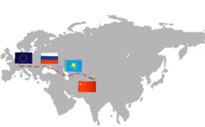
The Committee for Roads (CR) under the Ministry of Transportation and Communications (MoTC), Republic of Kazakhstan awarded the Contract to Swedish National Road Consulting AB (SWEROAD) on 31st July 2013 to conduct the following under the Component 1 and 2:
Component 1: Road Safety Audit of 1062km of road sections and review of Traffic Management at Road Works Republic of Kazakhstan: South-West Roads Project (SWRP). The SWRP is to construct and upgrade approximately 1,062 km of road sections between the Aktobe/Kyzylorda oblast border and Shymkent (including a northern bypass to the city), and is supported by a World Bank loan in the amount of USS2.125 billion. The proposed Project is part of the Government’s program to upgrade and improve the 2,840 km road corridor linking Europe and Russia to China through Kazakhstan. The overall objective of the Government’s WE-WC Corridor development program is to improve transport efficiency and safety, and promote analyses along one of the Kazakhstan’s main strategic road transport corridors. Transport and trade efficiency will be improved through provision of better infrastructure and services along the entire corridor to reduce transport costs, and through gradual reform of the entities responsible for all categories of roads. As part of the road corridor development, the SWRP finances this consulting service for development of framework to improve road services along the project road sections.
One of the objectives of the SWRP is to improve traffic safety. Development of WE-WC Road Corridor is a major investment project in the country and it is imperative to ensure that the road is safe for all users both during the period of construction and after, when it is open to the public. There is a sense of urgency to prevent any accidents from happening during construction, and ensure that the road is built taking into account good practice in road safety.
ROAD SAFETY AUDIT
It is important to ensure that the road is as safe as possible. One of the best ways to reduce risk on a new road is to engage the road safety audit process. It is a form of safety insurance for a new road and it is now a component of most national road safety strategies. Road safety audit is a process of crash prevention - it aims to identify safety concerns in a road design so that changes can be made at the design stage or early during construction as would be the case in Kazakhstan.
Experience worldwide confirms that it is much easier and more cost- efficient to address any weaknesses at the design and construction stage than to make changes when the road is built and open to traffic.
Road safety audit (RSA) is a systemic and formal safety performance examination of a road project to identify any potential safety problems so that, where possible, the design can be improved to eliminate or reduce them. They assess how a proposed new or improved road will work once it is open to traffic, focusing on the safety of users - including pedestrians, cyclists, motorcyclists, as well as truck, bus and car drivers and their passengers. The audit should be carried out by qualified and experienced auditors (road safety experts) who are independent of the scheme designers. Road safety auditing can produce significant benefits at low cost if carried out in a formal and coordinated manner at all stages in the planning, design and implementation of a road project. The process requires strong management commitment, skilled auditors, cooperation from design teams, and an on-going training program. The evidence from countries that have adopted safety auditing suggests that the costs of changes introduced as a result of a safety audit are significantly outweighed by the safety benefits, namely fewer crashes, less severe crashes, and less damage to road furniture.
Component 2: “Strategy for Development of Road User Services” and its Pilot Implementation Republic of Kazakhstan: South-West Roads Project: Development of road user services plays a critical role in achieving the development objectives of the SWRP, enabling and facilitating domestic transport, international transit and trade. This note lays out the concept and key elements of road user service development along the South West Roads in an attempt to assist the implementing agency of the SWRP, the Committee for Roads of the Ministry of Communications and Transportation.
Road User Services - Concept and Characteristics
Road user services are defined as services provided to road users—both drivers (including truckers) and passengers—in premises and facilities within, or in the vicinity of, the right-of-way of major roads. From the road user’s perspective, road user services can be classified by type of needs as listed below:
1) Travel necessities: Services that address essential travel needs, such as vehicle refueling, food, fresh water, emergency/rest stops, and emergency calls;
2) Travel information service: Basic road corridor and journey information that assists trip planning, such as road maps, service maps, distance and estimated travel time to destinations, weather forecast, etc.; as well as locai area information on cultural heritage and natural resources that promotes tourism;
3) Retail service: En route stops that fulfill travelers’ needs, as well as destinations that attract new shopping trips, such as farmers’ markets, shopping mails, and markets for local specialties;
4) Leisure and tourism: Services for enjoyable travel experience beyond fulfilling mere necessities, such as restaurants, lodging, cafe, parks, picnic areas, etc., and services provided to visitors at tourism destinations;
5) Public transport: Inter-city and inter-town public transport services along the road corridor accompanied with adequate travel information, stops and terminals, connected to feeder transport services that serve in-town trips; and
6) Services to freight transport: Facilities, information and personnel that provide (a) enforcement of regulations and laws with respect to freight transport, for example, maximum working hours of truck drivers and cargo loading; (b) logistics services such as transit hubs, intermodal connections, connections to inland depots, dry ports, or logistic terminals, and (c) business facilities such as cold-chain, dangerous goods handling, perishable goods handling.
Road user services are of critical importance in road network development as they can have great impacts on road user experience as well as on the development of local communities alongside roads. Careful planning, designing and appropriate policy measures are therefore crucial in development of road user services.
The Consultancy services of the above components commenced on 18th September, 2013 in association with KazdorNII JSC of Kazakhstan as sub-Consultant. The Consultant’s technical approach, methodology and organization structure presented within the Inception Reports of the Component 1 and Component 2 on October and November 2013 respectively
All these are derived from Consultants Study of the Terms of Reference (ToR) and fact finding study to trip to the project road sections on September 19th – 23rd for Component 1 and from 14th – 28th October 2013 for Component 2.
In order to clarify the various activities under the above Consultancy Services and meaning full understanding of the Consultant’s (SWEROAD) Work Plan, a presentation of the Inception Reports was made on February 5th in presence of all stakeholders of the project in the Committee for Roads Ministry of Transport and Communications. (Inception Report presentations under Components 1 & 2 are published on our website section “Abouth the project” subsection “The map of the project, slides, schemes, models”).



















